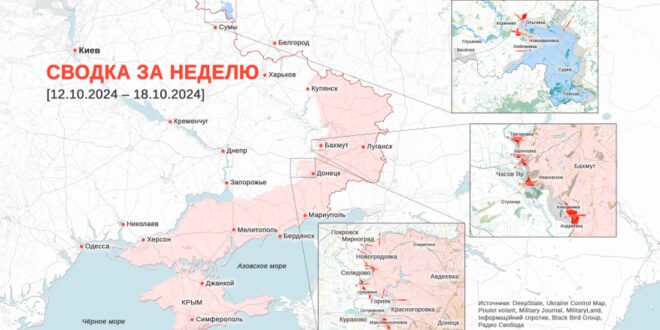In today’s summary:
- The counteroffensive of the Russian Armed Forces in the Kursk region has run into previously lost Russian fortifications in some areas
- In the Kursk rear, unknown persons placed “dragon’s teeth” on the roads, which led to numerous fatal accidents
- Russian troops are outflanking Selidovo, the Ukrainian garrison will have to leave the city in the near future
- The Russian Armed Forces occupied a significant part of Toretsk and broke through the Seversky Donets-Donbass canal to the southern outskirts of Chasov Yar
- GUR units carried out two successful frontline operations – in the north of the Kharkov region and on the left bank of the Oskol River
- The first confirmations of the transfer of North Korean troops to Russia to participate in combat operations against the Ukrainian Armed Forces have appeared
- The BBC Russian Service and the Mediazona publication note a sharp increase in obituaries about the deaths of Russian soldiers
- Australia announces plans to send 49 retired M1A1 Abrams tanks to Ukraine
- The situation at the front
- The counteroffensive of the Russian Armed Forces in the Kursk region has continued since the beginning of the week ( 1 , 2 ), but in some areas it has run into Russian fortifications previously occupied by the Ukrainian Armed Forces. Nevertheless, the Russian Armed Forces have managed to almost completely eliminate the Ukrainian penetration in the border area of the Glushkovsky district. The Ukrainian Armed Forces, apparently, maintain a presence in the area of Lyubimovka (where a Russian column of armored vehicles was routed) and Olgovka in the northwest of the Kursk bridgehead. In general, Z-bloggers agree that the initial successes of the offensive have not led to the collapse of the Ukrainian Armed Forces’ defense ( 1 , 2 ). In total, Ukrainian troops have left up to a quarter of the territory of the Kursk region they captured.
The beginning of the thaw ( 1 , 2 ) plays on the side of the Russian Armed Forces , reducing the Ukrainian Armed Forces’ advantage in drones and allowing the Russians to realize their superiority in tracked vehicles, which have higher cross-country ability. Russian troops, in turn, faced an unexpected problem – the installation of “dragon’s teeth” on rear roads, which at night leads to losses in road accidents exceeding the damage from Ukrainian FPV drones . The barriers were subsequently removed , but the roads remain dangerous due to remote mining. Meanwhile, another piece of evidence of attempts to replenish the ranks of the Russian group by any means other than mobilization has appeared in the Kursk direction – a rifle regiment recruited from the Strategic Missile Forces .
In the Pokrovsk direction, the Russian Armed Forces continue to encircle Selidovo from the flanks, which has forced observers to talk about the threat of encirclement, as a result of which the Ukrainians defending the city may be forced to abandon it . The Russian military allegedly managed to cut off one of Selidovo’s supply routes, although the Ukrainian side has not confirmed this information. Meanwhile, to the south, the Russian Armed Forces are advancing in the direction of Kurakhovo , having distinguished themselves with “flag-strikes” in Ostrovskoye and Maksimilyanovka . Among the factors slowing down the Russian offensive, they name weather conditions, a shortage of people, and the enemy’s superiority in UAVs .
At the same time, the Russian Armed Forces, according to the “head of the DPR” Denis Pushilin, managed to occupy three-quarters of Toretsk (until 2016 – Dzerzhinsk). The Russian command is transferring “DPR” fighters who know the area and pro-Russian residents to command positions in this direction, and the Ukrainian military has no hope of holding the city due to a shortage of personnel.
In the area of Chasov Yar, Russian troops managed to force the Seversky Donets-Donbass canal in two places at once – to the southeast of the city and in the Oktyabrsky microdistrict , where the Kadyrovite with the call sign Shustry distinguished himself . DeepState admits that the situation around the city is getting more complicated.
This week, the GUR special forces demonstrated two successful frontline operations at once. The special forces cleared the forest near the village of Liptsy in the north of the Kharkiv region , reportedly destroying almost an entire enemy regiment, and also announced the liberation of Kruglyakovka near the Oskol River , thereby reducing the threat of the Ukrainian Armed Forces bridgehead on the left bank being cut in two. The decision of the Kharkiv OVA on the mandatory evacuation of four communities in the Kupyansk district and the city of Kupyansk itself speaks of the grave situation in this area .
Rumors and statements that have been spreading recently about the possible participation of North Korean troops in combat operations on the side of Russia have received some confirmation. A video has appeared with supposedly North Korean troops at the base of the 127th Motorized Rifle Division in the village of Sergeyevka in Primorsky Krai, and South Korean intelligence has reported the transfer of the first 1,500 North Korean fighters by sea to Russian territory. In total, 12,000 people are being sent (earlier, the head of the Main Intelligence Directorate, Kirill Budanov, spoke of 11,000 people).
The Insider summed up the interim results of the Russian offensive for the year, which began with the “meat assault” on Avdiivka in October 2023. One of the main conclusions of the article is that despite the huge losses in manpower and equipment, at this rate it will take several years to capture the Donetsk region alone.
The Insider also tells the stories of Africans who went to Russia for a better life and unexpectedly found themselves in the trenches.
Mutual shelling and sabotage
The Ukrainian Air Force Command reported ( 1 , 2 , 3 , 4 , 5 , 6 ) on raids by a total of 440 Russian UAVs, including the Shahed type, over the past week . Of these, 237 were shot down, and another 175 were “lost in location,” including under the influence of electronic warfare . Launches of about 20 missiles of various types were also noted, with no interceptions reported. According to monitoring channels, the night of October 14 passed for the first time in 48 days without the use of Russian UAVs.
The Russian Defense Ministry reported ( 1 , 2 , 3 , 4 , 5 ) the interception of 79 aircraft-type drones over Russian territory. Also this week, footage was published ( 1 , 2 ) showing that both sides are using drones without warheads as decoys , which do not explode, but are still included in the statistics of shot down and “location lost”.
A missile strike was carried out on Nikolaev — the local OVA reported one dead , 23 wounded , and damage to an infrastructure facility, a restaurant, shopping pavilions, residential buildings, and cars. The Russian Defense Ministry reported the defeat of a local armored plant . The Russian Armed Forces also once again struck the port infrastructure of Odessa (two civilian ships and a grain warehouse were damaged, one person was killed, eight were wounded) and continued their “people safari” in Kherson and the region — a UN refugee agency vehicle was damaged , and two elderly women were killed and two more people were injured as a result of an FPV drone strike on a civilian car .
The Ukrainian Armed Forces carried out strikes on a training ground and oil depot in Rovenki in the occupied Luhansk region (previously attacked in May) and on an ammunition depot in the Penza region (there was no detonation, as reported). A missile attack on occupied Crimea failed, Rybar reports . Shelling of the Belgorod region continued – during one of the attacks on Shebekino, 8 people were wounded , and in the village of Petrovka, two self-defense fighters were injured . The Belgorod region has suffered the most civilian casualties in the border regions since the beginning of the full-scale war – such data is cited by Russian ombudsman Moskalkova, and in total she counted 398 dead and 1,157 wounded civilians.
Losses
The BBC Russian Service and the Mediazona publication, together with a team of volunteers, updated the count of casualties in the war on the Russian side based on reports in open sources. In total, 74,014 people are known to have died; 2,010 names were added to the list between October 4 and 18. Researchers have noted a sharp increase in the number of publications about Russian deaths in the war in recent weeks compared to the average for 2022–2023.
DeepState reported on a new shooting of nine Ukrainian prisoners of war that took place on October 10 in the Kursk region near the village of Zelenyi Shlyakh . The dead were allegedly UAV operators. The Office of the Prosecutor General of Ukraine also reported on the shooting of a wounded Ukrainian serviceman by Russian troops near Bakhmut. The department reports that the Ukrainian serviceman was killed when he was unarmed and lying on the ground.
The Telegram channel “Spy Dossier” reported the loss of a Su-25 attack aircraft by the Russian Aerospace Forces near Bakhmut on October 2, 2024. According to the channel’s authors, the aircraft was shot down “probably as a result of friendly fire.” The same channel provided the names of the Su-34 fighter-bomber crew members who died on October 12. Fighterbomber had previously reported the loss of the aircraft . Russian sources have not named the cause of the crash, but deny the version that the Su-34 was shot down by an F-16 fighter.
Analyst Naalsio updated the data on visually confirmed losses of military equipment in the Kursk region. During the period from October 7 to 15, 20 units of Ukrainian equipment and 26 Russian were added – against the backdrop of the Russian counteroffensive, weekly losses of the Russian Armed Forces exceeded those of Ukraine for the first time . Over the entire period of the operation in the region, the Ukrainian Armed Forces lost 251 units, the Russian Armed Forces – 181 units.
Weapons and military equipment
Australia will transfer 49 M1A1 Abrams tanks to Ukraine , which are planned to be replaced with more modern M1A2 tanks . Another 8 Leopard 1A5 tanks have already been delivered by Germany, and the list of completed deliveries also includes 20 Marder infantry fighting vehicles , six PzH 2000 self-propelled guns , reconnaissance drones and artillery ammunition.
The United States has allocated a new military aid package to Ukraine under the PDA in the amount of $425 million. The package mainly included ammunition, in particular for artillery, air defense and HIMARS MLRS , as well as anti-tank weapons. At the same time , it became known that the United States is lagging behind the schedule for increasing the production of 155-mm artillery rounds – by the end of the year, it is planned to reach 55 thousand ammunition per month instead of the previously planned 70-80 thousand.
In addition, the training of F-16 pilots risks being delayed again, as Ukrainian cadets were used due to the impossibility of distracting more experienced pilots from combat missions. At the same time, Greece has promised to assist in the training, in particular training of technical personnel.
The US also transferred a third Patriot air defense system battery to Ukraine , according to the list of military aid provided. Thus, the Ukrainian Armed Forces currently have 10 “anti-ballistic” systems in service, including 8 Patriots and two SAMP/Ts.
In addition, new military aid packages were announced by:
Denmark (contents not disclosed),
France (announced the start of deliveries of French-designed kamikaze drones, which appear to be unreasonably expensive),
The Netherlands (we are talking about a joint investment with Denmark in the purchase of ammunition within the framework of the “Czech initiative” , as well as self-propelled howitzers),
Canada (the package will include small arms, ammunition and funds for training Ukrainian Armed Forces personnel).
Meanwhile, pre-war stocks of MLRS at Russian storage bases have almost been exhausted – out of 1,474 different installations, only 339 units remain, or 23% , and they are most likely in unsatisfactory technical condition. In addition to the shortage of stocks, the Russian military-industrial complex is also suffering from Western sanctions – the US Treasury Department’s list includes Chinese and Russian developers of the Harpia UAV. Sanctions were also used to explain the unsatisfactory quality of UAZ vehicles, which are widely used at the front and are constantly criticized by the Z-community. Dmitry Rogozin announced that his “military-technical detachment BARS-Sarmat” will be engaged in quality control at the car plant.
While waiting for high-quality “Loaves”, the Russian military is “luring” the Chinese Desertcross and BMP-3 all-terrain vehicles ( the factory protection of the latter is obviously unsuitable for combat conditions). The Ukrainian Armed Forces, in turn, are equipping Leopard 1A5 and Leopard 2A6 tanks with dynamic protection , lattice screens and folding “barbecues”.
 Eurasia Press & News
Eurasia Press & News



